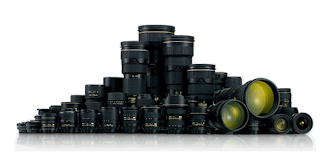Before that, What is SLR and DSLR?
SLR is single-lens reflex camera
DSLR digital single-lens reflex camera
Now to the lens
Also known as photographic lens, objective lens or photographic objective
is an optical lens or assembly of lenses used with a camera body to make images of objects capable of storing an image chemically or electronically
A lens may be permanently fixed to a camera, or it may be interchangeable with lenses of different focal lengths, apertures, and other properties
FOCAL LENGTH
The lens' focal length determines the magnification of the image projected onto the image plane
- with a short focal length you have to be close to your subject for a close-up
- with a long focal length you can be far away and still get a close-up
APERTURE
The aperture the light intensity of that image
Easily to say, aperture means the amount of light let in by the lens or the gap the lens has
These are the standard aperture scale
f/1.4 f/2.0 f/2.8 f/4.0 f/5.6 f/8.0 f/11 f/16 f/22 f/32
Smaller Aperture Number (2.8) = Wider Aperture = More Light
Larger Aperture Number (22) = Narrower Aperture = Less Light
Lenses are not interchangeable
A lens designed for a Nikon camera is not going to work on Canon camera and vice versa
The reason is that modern day lenses have an electronic connection with the digital SLR camera
This connection relays information from lens to camera such setting changes on the lens (like aperture) from the camera body itself
Types of DSLR lens
- Standard Lenses
Traditionally on film cameras it was used to describe lenses in the 50mm range
Usually came with the camera
- Kit Lenses
Offered as a package with the DSLR
Generally an entry level quality zoom lens
General purpose lens designed for everyday shooting
- Prime Lenses
One focal length only
Are known especially at the top end for their image quality and speed faster aperture
- Telephoto Zoom Lenses
Most popular DSLR
Benefits of zoom-do not need to physically get closer to subject
- Macro Lenses
Specifically designed for shooting objects up close
- Wide Angle Lenses
Enable users to take shots with a very wide perspective
Useful for landscapes
SWEET...ISN'T IT?? LET DREAM COME TRUE....LET A CANON DELIGHT YOU ALWAYS
(C) jeeknowsthis.blogspot.com/information from digital-slr-guide.com/digital-photography-school.com/wikipedia.com










Thanks bro....if can try to give some tips to select the suitable Lenses...thanks.
ReplyDeleteThanks bro..yes do like what anna says...
ReplyDeletethanks for the request guys...actually I had prepared the steps to select the suitable lens but I missed it out in the post
ReplyDeleteFollowing these 6 steps can assist in buying lens
1. Determine the focal length needed
2. Decide whether a prime or zoom lens
3. Select a maximum aperture
4. Choose between first or third party lenses
5. Evaluate any extra features
6. Read reviews and narrow options
BUT REMEMBER, CHEAP LENS MAY SOMETIME HAVE A NEGATIVE IMPACT ON THE IMAGE QUALITY
SPENDING BIT MORE MONEY WHEN PURCHASING THE LENS WILL ONLY RESULT IN GOOD QUALITY PICTURES
hope these steps can assist in selecting the best lens for your camera
Thanks buddy....for sure it will help....coming week i wanna buy a digital camera so i'll survey for the best SLR....planned to get one after Christmas....
ReplyDeletebro canon 60d or 50d would be the best....
ReplyDelete